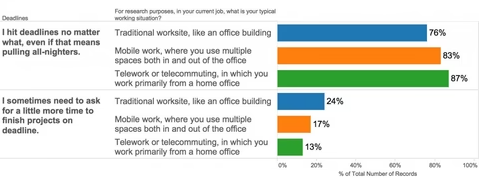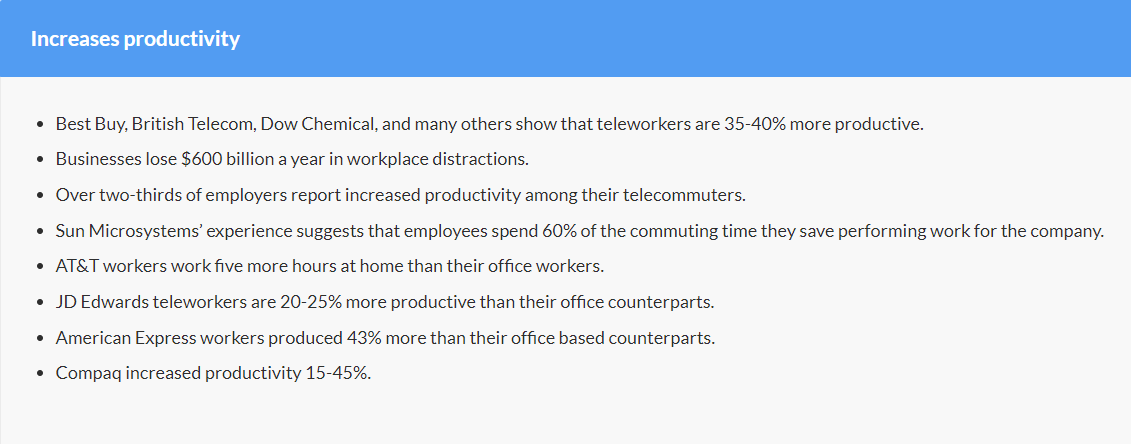

The requirement for a water proof remote working strategy has never been more critical, or more in the spotlight, and whilst on paper this can seem like an open goal with many business benefits, there are unique challenges that IT leaders must address to make the most of their remote work strategies.
This guide takes a look at some of the key business drivers behind creating a remote working policy, as well as the challenges and technology solutions that can make supporting, enabling and developing your remote workforce significantly easier.
Why implement a Remote Working policy?
What are you trying to accomplish? Whether it’s to provide current employees with more flexible work arrangements or beef up your business continuity strategy it’s key to understand why building out remote working guidelines is worth your time and energy.
Here we look at several tried and tested justifications of any remote working policy:
- Employee Satisfaction
- Wider Talent Pool
- Disaster Recovery
- Lower Infrastructure costs
- Reduction in Carbon Footprint
Employee satisfaction
It has been identified that employees who are engaged and motivated within their job role have higher employee satisfaction, a survey carried out by Leadership IQ identified that only 24% of office workers said they loved their jobs, compared to the 45% of remote workers who did. It is this higher rate of job satisfaction in remote workers which can lead to improved productivity, increased profitability, reduced absenteeism and increase employee loyalty.


Remote working can improve mental health, by lowering stress level in up to 82% of workers.
This can have a positive effect on overall company growth in the form of higher employee retention and lower turnover. As we enter the year of 2023, where mental health awareness is at its peak, it’s crucial that organisations are providing their employees with opportunities to increase their job satisfaction. A study conducted by The Ohio State University revealed that there is a close relationship between mental wellbeing and job satisfaction, therefore employees who are consistently reporting low employee satisfaction were at a higher risk of excessive worrying, depression and sleep problems.
You can test your own, or your employees’ suitability for remote working using this online test.
The CEO of DropBox has very positive attitudes to remote working as you can see for yourself in his CNN interview:
Wider Talent Pool
Multinational companies don’t have any difficulty with talent pools. They already have offices and branch offices in numerous countries. Yet even these companies expand their pool through remote working. Any form of flexible working increases the likelihood that talent will choose your company, stay more loyal and have greater job satisfaction.
Additionally, you have the option of acquiring the best talent from across the entire world if you so desire. At VirtualFirst we have people working across the globe. In fact, Adam, reckons that our working pattern is fair dinkum. No prizes for guessing where he mainly works!
Mainly is the right word for this, as, taking Adam as an example, he visits family in good old blighty for months at a time but his work is unimpeded. He isn’t quite a digital nomad but his ability to work wherever he is on the planet is indicative of the work-lifestyles of many superb talents.


You may have heard of digital nomads. These are mainly young professionals who combine a desire to experience the wonders of the world and its peoples while holding down a day job or working on contracts. Again, this is a pool of talent that you can access through a remote working strategy.
Business Continuity
Most companies already have a disaster recovery plan (DRP) in place for their IT services. They make sure their data is backed up daily and have written up procedures in place to restore a failed piece of hardware should they ever need to. But what happens when their voice services are disrupted?
Any number of events can occur to make an office voice services unusable – from builders accidentally cutting through cables during road works, to an epidemic that results in high staff absenteeism, or even a natural disaster that damages an office. When staff are unable to answer the phones, business grinds to a halt.
If a company has already set up remote working arrangements with a well-developed infrastructure it is likely that business will be able to continue as normal, with no mishaps. In fact, businesses that had already adopted a remote working model saw no disruption to their working practices during the pandemic.
The government has provided excellent advice on business resilience. If you haven’t seen this advice you can download the pdf.
Lower Infrastructure Costs
If you don’t have an office then you immediately eliminate a large number of costs like office rent, cleaning, water provision, health and safety issues, employee and public liabilities, energy consumption and utility bills, maintenance, upgrades, furnishings, and so on.
Global Workplace Analytics, have estimated that remote working could save over $700 billion dollars every year. That works out at $11,000 dollars per employee for year. Perhaps you have already performed the calculation in your head that scales that figure to the size of your company.
However ,there are hidden savings too. Absenteeism drops and return to work after medical problems or surgery increases. Together, this saves around $1800 dollars per year per employee.
Productivity also increases. Major companies report a gain of 35-40% in productivity through remote working. Now, you might be saying to yourself that this is not a cost. Look at it as an inverted cost of not doing remote working.


Reduced Carbon Footprint from Remote Working
The obvious way remote working reduces a companies carbon footprint is not having an office with all its energy requirements. Just taking a look at your monthly utilities bill will give you an idea of how much of a carbon load you are producing.
The following is a fairly complete list of the sources of carbon in most offices.
- Electricity
- Heating
- Refrigeration and cooling
- Ventilation
- Water
- Waste
- Vehicles and equipment
- Employee commuting
- Employee travel
- Property maintenance and management like lawn care and landscaping (if applicable)
- Servers (if applicable)
- Purchased goods and services
Most offices have some form of air conditioning. This source of greenhouse emissions accounts for almost 4% of global emissions. The air conditioning figures don’t just include carbon dioxide but also the leakage of refrigerants which are even more potent greenhouse gases than carbon dioxide.


Now, you are probably already thinking that the environmental cost of your business is just being displaced from the office to home locations. People working from home will use more energy.
This is true. However, the research shows that the reduction in greenhouse emissions when working from home is adopted amounts to 3.2 metric tonnes per employee per year.
Key challenges your strategy should tackle
It’s not all sunshine and sunny uplands though. Enabling remote workers to be effective is more than simply equipping them with a smartphone or a laptop. Without the right tools remote working can have a negative impact on employee productivity. Additionally, if remote workers are lacking in enthusiasm and not receiving the essential support they need to be efficient and effective, the knock-on effects for your business will quickly become apparent.
In effect there are anew set of HR challenges that need to be catered for.
Challenges
- Lower job satisfaction – Remote workers often feel they are not able to be productive because they don’t have access to the right information, contacts and tools when they are away from the office.
- Feelings of exclusion – Remote workers frequently feel excluded because they miss out on important communications, or they don’t have the same level of interaction with their other colleagues as office-based
workers. - Frustration at inability to perform – Remote workers commonly complain of feeling inconvenienced and frustrated because they have to carry separate business and personal devices and use multiple tools for work communications – many of which aren’t designed for use in a mobile environment.
- Interruptions and distractions – One of the most obvious challenges for remote workers are interruptions and distractions. They can seriously damage your productivity. After a distraction it can take a while to get back into the deep focus that leads to quality work.
- Poor service delivered to customers – This is particularly a problem because remote workers often can’t be easily contacted when they need to be, or they don’t have the right information at hand to deal with a customers issue.
- Important decisions delayed – When key people are away from the office, or poor decisions are made because people don’t have access to complete information.
- Increased risk of security breaches – Commonly because employees end up using non-approved consumer apps to communicate or to store information, as it’s simply easier. As much as 60% of hacks target small businesses.
- Loss of valuable information – This is becomes an issue when an employee leaves and company data or contacts are stored on the workers personal phone. This is a serious breach of GDPR regulations and can lead to substantial fine of up to 2% of your turnover.
Solutions for Successful Remote Working
Mobile workers still face incredible challenges and frustration when they don’t have the right tools to keep them aligned with the rest of the organisation.
So how are these challenges overcome?
What solutions can be put in place and how do you know which solution is right for you?
Solutions
- A platform to unify your business communications – Unified Communications is a reliable infrastructure which enables businesses to integrate all of the ways they communicate, including voice, video and data. It’s easy to deploy and roll out to employees around the world, as well as being a cost effective solution. And, crucially, it can help to facilitate remote working and communication between teams in different places.
- A business Grade Mobile Service – Traditionally, businesses have been hamstrung by limited access to good value, reliable mobile data services, often having to rely on products initially created for the consumer market. Your employees will have a wide range of requirements from their mobile service, from using it to make and receive calls, to it becoming a potential source of connectivity should their home broadband fail.
- An integrated cloud based phone system – Hosted phone systems have long replaced traditional desk phones and taken advantage of today’s high-speed broadband and mobile technology. Combining fixed and mobile telephony into a user-controlled online interface equips employees with powerful and flexible usability features to ensure they have the full fat technology they are used to at their office when based remotely.
- Tighter security can be implemented through training to raise cyber awareness among staff, creating a knowledgeable and confident work culture surrounding cyber threats that will significantly reducing the risk of a security breach.
Many cloud based phone systems offer CRM integration – this can be an easy way to ensure your teams can access the right contact details for customers and suppliers for mobile workers.
For more information on these solutions, have a look at our services.
We can Help Your Transition to Remote Working
For the expertise that you need contact us for advice and analysis at https://virtualfirst.uk/contact/
